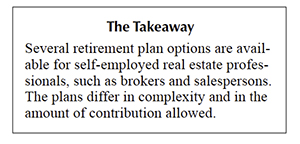Retirement Plans for Self-Employed

You might also like

TG Magazine
Check out the latest issue of our flagship publication.
Helping Texans make the best real estate decisions since 1971.
As the state’s population grows, so does the need for more housing. Here are the data and tools you need to keep up with housing market trends in your area.
Whether you’re talking about DFW’s financial services industry, Austin’s tech sector, Houston’s energy corridor, or the medical hub that is San Antonio, commercial real estate is big business in Texas.
Mineral rights. Water issues. Wildlife management and conservation. Eminent domain. The number of factors driving Texas land markets is as big as the state itself. Here’s information that can help.
Texas is a large, diversified state boasting one of the biggest economies in the world. Our reports and articles help you understand why.
Center research is fueled by accurate, high-quality, up-to-date data acquired from such sources as Texas MLSs, the U.S. Bureau of Labor Statistics, and the U.S. Census Bureau. Data and reports included here are free.
Stay current on the latest happenings around the Center and the state with our news releases, NewsTalk Texas online searchable news database, and more.
We offer a number of educational opportunities throughout the year, including our popular Outlook for Texas Land Markets conference. Check here for updates.
Established in 1971, the Texas Real Estate Research Center is the nation’s largest publicly funded organization devoted to real estate research. Learn more about our history here and meet our team.


 While inflation has been fairly low in recent years, limits on contributions to retirement accounts have risen steadily. The revised limits make such accounts significantly more attractive for self-employed workers. This is good news for real estate brokers and sales associates operating as independent contractors who are considered self-employed for tax purposes, rather than employees.
While inflation has been fairly low in recent years, limits on contributions to retirement accounts have risen steadily. The revised limits make such accounts significantly more attractive for self-employed workers. This is good news for real estate brokers and sales associates operating as independent contractors who are considered self-employed for tax purposes, rather than employees.
Several retirement plans exist for the self-employed. The plans differ in complexity and in the amount of contribution allowed. The least complicated plans are Roth IRAs and Deductible ("Traditional") IRAs.
Roths are generally considered a better option than Deductible IRAs. Contributions to Roth IRAs are nondeductible, but all qualified withdrawals are tax free. There is no age limit for contributions and no mandatory withdrawals. A 10 percent penalty plus regular income tax applies to Roth earnings if withdrawn prior to age 59½, but there are several exceptions to the penalty.
For example, the penalty does not apply to the first $10,000 of "qualified first-time homebuyer distributions" used to purchase or construct a home. To be considered a "first-time homebuyer" for this rule, the buyer and his/her spouse must not have owned a home for the two prior years. Homes owned prior to two years ago are ignored.
A major advantage of Roths is that there is no tax rate risk. For instance, the remaining options discussed here require income tax to be paid on withdrawals, a disadvantage because future tax rates are unpredictable. In contrast, qualified withdrawals from Roths avoid tax rate risk because they are tax free.
Contributions to Roths are generally limited to $5,500 per year ($6,500 for those 50 years or older). However, the limits begin to phase out for married taxpayers filing jointly whose adjusted gross income (AGI) exceeds $183,000. Contributions are precluded once AGI reaches $193,000. For singles, the AGI phase-out range is $114,000 to $129,000. SEP-IRAs and SIMPLE-IRAs, discussed later, offer larger annual contributions.
In contrast to Roths, contributions to Deductible IRAs provide a tax deduction in the year they are made. All qualified withdrawals are taxable as ordinary income and are thus subject to tax rate risk.
Penalty-free withdrawals can begin at age 59½ and must be taken at 70½ and each year thereafter. No contributions are allowed after 70½. As with Roths, withdrawals prior to age 59½ are subject to a 10 percent penalty in addition to tax on the amount withdrawn. Exceptions to the 10 percent penalty are the same as those for Roths. With or without the penalty, income tax must be paid on the entire amount withdrawn. In contrast to Roths, AGI limits are reduced if one or both spouses are covered by employer pension plans.
Self-employed workers can establish a Simplified Employee Pension (SEP) for themselves. Contributions are deductible and are made to the taxpayer’s Deductible IRA account (but not a Roth account). The annual contribution limit is the smaller of (1) 18.587045 percent of net self-employed earnings, or (2) $53,000 for 2015 (up from $52,000 in 2014). Roth and Deductible IRA contribution limits already discussed are not affected by SEP-IRA contributions.
A SIMPLE-IRA allows a self-employed person to make a deductible deposit of $12,500 ($15,500 if older than 50) per year plus a "matching" deductible contribution of up to 3 percent of self-employment net income. For example, a self-employed broker with $100,000 net self-employment income could contribute $15,500 to a SIMPLE-IRA ($12,500 plus 3 percent of $100,000) plus $5,500 to a Roth or Deductible IRA.
The optimal retirement strategy for one person may not be appropriate for another. Because of the complexity of retirement planning, consultation with a tax accountant or tax attorney is recommended.
____________________
Dr. Stern ([email protected]) is a research fellow with the Real Estate Center at Texas A&M University and a professor of accounting in the Kelley School of Business at Indiana University.
Receive our economic and housing reports and newsletters for free.
As the state’s population grows, so does the need for more housing. Here are the data and tools you need to keep up with housing market trends in your area.
Whether you’re talking about DFW’s financial services industry, Austin’s tech sector, Houston’s energy corridor, or the medical hub that is San Antonio, commercial real estate is big business in Texas.
Mineral rights. Water issues. Wildlife management and conservation. Eminent domain. The number of factors driving Texas land markets is as big as the state itself. Here’s information that can help.
Texas is a large, diversified state boasting one of the biggest economies in the world. Our reports and articles help you understand why.
Center research is fueled by accurate, high-quality, up-to-date data acquired from such sources as Texas MLSs, the U.S. Bureau of Labor Statistics, and the U.S. Census Bureau. Data and reports included here are free.
Stay current on the latest happenings around the Center and the state with our news releases, NewsTalk Texas online searchable news database, and more.
We offer a number of educational opportunities throughout the year, including our popular Outlook for Texas Land Markets conference. Check here for updates.
Established in 1971, the Texas Real Estate Research Center is the nation’s largest publicly funded organization devoted to real estate research. Learn more about our history here and meet our team.
Helping Texans make the best real estate decisions since 1971.
You are now being directed to an external page. Please note that we are not responsible for the content or security of the linked website.